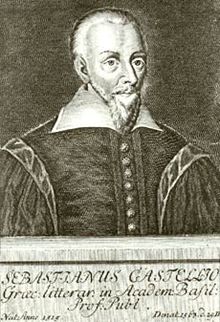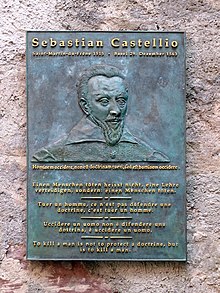Sebastian Castellio
Sebastian Castellio (juga Sébastien Châteillon, Châtaillon, Castellión, dan Castello; 1515 – 29 Desember 1563) adalah seorang pengkhotbah dan teolog Prancis; dan salah satu pendukung Kristen Reformed pertama toleransi beragama, kebebasan hati nurani, dan berpendapat.
| Sebastian Castellio | |
|---|---|
 | |
| Lahir | 1515 Saint-Martin-du-Frêne, Kadipaten Savoy |
| Meninggal | 29 Desember 1563 (umur 47–48) Basel, [[Konfederasi Swiss Lama |Konfederasi Swiss]] |
| Kebangsaan | Prancis |
| Pekerjaan | Pengkhotbah, profesor, teolog, penerjemah |
| Karya terkenal | De haereticis, an sint persequendi |
| Kiprah di bidang teologi | |
| Gagasan terkenal | Kebebasan berpendapat |

Biografi
Castellio lahir pada tahun 1515 di Saint-Martin-du-Frêne di desa Bresse, Dauphiné, sebuah desa yang berbatasan dengan Swiss, Prancis, dan Savoy. Di bawah pemerintahan Wangsa Savoy, keluarganya menyebut diri mereka Chateillon, Chatillon, atau Chataillon. Setelah menempuh pendidikan pada usia dua puluh tahun di Universitas Lyon, Castellio fasih berbahasa Prancis dan Italia, serta menjadi ahli dalam bahasa Latin, bahasa Ibrani, dan bahasa Yunani. Selanjutnya, ia belajar bahasa Jerman saat ia mulai menulis karya-karya teologis dalam berbagai bahasa Eropa.
His education, zeal and theological knowledge were so outstanding that he was considered to be one of the most learned men of his time — equal, if not superior, to John Calvin. Regarding Castellio, according to A Conscience Against Violence of Stefan Zweig, Voltaire wrote: "We can measure the virulence of this tyranny by the persecution to which Castellio was exposed at Calvin's instance — although Castellio was a far greater scholar than Calvin, whose jealousy drove him out of Geneva."[1]
Castellio later wrote that he was deeply affected and moved when he saw the burning of heretics in Lyon by the French Inquisition,[2] and at the age of twenty-four he decided to subscribe to the teachings of the Reformation. In the spring of 1540, after witnessing the killings of the early Protestant martyrs, he left Lyon and became a missionary for Protestantism.[2]
hominem occidere non est doctrinam tueri sed hominem occidere. (To kill a man does not mean to protect a doctrine, it means to kill a man.)
— Castellio, Contra libellum Calvini [Against Calvin's Booklet] (dalam bahasa Latin)
Karya
- Dialogi Sacri. Jenewa 1542, juga versi yang lebih diperluas, Basel 1545
- Biblia interprete Sebastiano Castalione . Basel 1551
- Itu adalah sebuah keharusan. Basel 1554
- La Bible nouvellement translatée . Basel 1555
- De arte dubitandi.
- Conseil à la France désolée. 1562
- De Imitatione Christi. 1563
Bibliografi
- Bainton, Roland (2005). Hunted heretic : the life and death of Michael Servetus, 1511-1553. Providence, R.I: Blackstone Editions Unitarian Universalist Historical Society. ISBN 0-9725017-3-8.
- Gordon, Bruce (2011). Calvin. New Haven Conn. London: Yale University Press. ISBN 978-0-300-17084-9.
- Guggisberg, Hans R. (2003). Bruce Gordon, ed. Sebastian Castellio, 1515–1563: Humanist and Defender of Religious Toleration in a Confessional Age. Aldershot: Ashgate. ISBN 0-7546-3019-6.
- Zweig, Stefan (1936). Castellio gegen Calvin oder Ein Gewissen gegen die Gewalt [Castellio against Calvin or a conscience against violence]. Vienna: H. Reichner. OCLC 1903690.
- Zweig, Stefan (1951). Erasmus; The Right to Heresy: Castellio against Calvin. London: Cassell. OCLC 24340377.
- Greminger, Ueli (2015). Sebastian Castellio - Eine Biographie aus den Wirren der Reformationszeit. Zurich: Orell Fuessli. ISBN 978-3-280-05597-7.
Pranala luar
- Hak untuk Sesat: Castellio Melawan Calvin oleh Stefan Zweig
- Sebastian Castellio dan Perjuangan Kebebasan Hati Nurani
- Liberalisme Erasmian Sebastian Castellio
- Castellio versus Calvin
- Opera baru yang menampilkan Sebastian Castellio
- ^ Zweig, Stefan (1936). The Right to Heresy: Castellio against Calvin . New York: The Viking Press. hlm. 89.
- ^ a b Zweig 1951, hlm. 239.